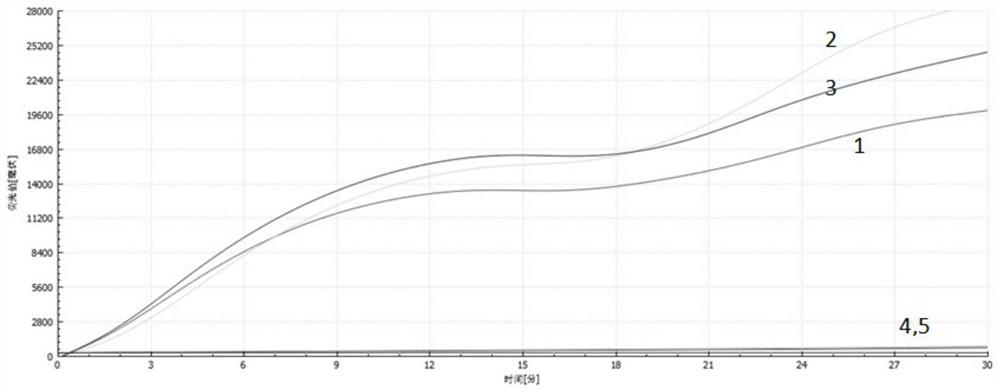Primer, probe, kit and detection method for detecting real-time fluorescence RAA of shiga toxin-producing escherichia coli
A technology for Escherichia coli and Shiga toxin production, applied in the field of molecular biology detection, can solve the problems of expensive instruments, high requirements for operators, and difficulties in popularization and application in grassroots laboratories, and achieve the effect of simple method and low price
- Summary
- Abstract
- Description
- Claims
- Application Information
AI Technical Summary
Problems solved by technology
Method used
Image
Examples
Embodiment 1
[0043] Example 1: Primer and probe design
[0044] There are three main variants of Stx1: stx1a, stx1c and stx1d, stx1a is the most common, stx1c and stx1d are relatively rare, so the primer probe of the present invention is mainly designed for stx1a, but due to the sequence differences of the primer probe in the three variants Small, positive for the other two variants can also be amplified, but the signal is weaker than stx1a.
[0045] stx1a (NC_002695.1)
[0046]
[0047] Stx1c (DQ449666.1)
[0048]
[0049] Stx1d (AY170851.1)
[0050]
[0051] There are seven main variants of Stx2: stx2a, stx2c, stx2d, stx2dactivatable, stx2e, stx2f and stx2g, among which stx2a, stx2c and stx2dactivatable are the most common, and the remaining variants are relatively rare. Stx2f is quite different from other variants, and the primer probe of the present invention can amplify other variants except stx2f.
[0052] Stx2a (NC_002695.1)
[0053]
[0054] Stx2c (FR851896.1)
[00...
Embodiment 2
[0071] RAA detection method, comprises the steps:
[0072] (1), extract sample DNA;
[0073] a. Preparation of enrichment solution template DNA
[0074] i) Take 1mL of the bacterial solution and add it to a 1.5mL centrifuge tube, centrifuge at 12000g for 3min, and discard the supernatant;
[0075] ii) Add 1 mL of 0.85% sterile saline to completely dissolve the precipitate, centrifuge at 12000 g for 3 min, and discard the supernatant;
[0076] iii) Add 100 μL of sterile water and mix well, then boil in water bath for 10 minutes, and cool on ice;
[0077] iv) centrifuge at 12000g for 12min, and the supernatant is the template DNA.
[0078] b. Preparation of suspicious colony template DNA
[0079] For the isolated suspicious colonies, you can directly pick the suspicious colonies and follow step iii to prepare template DNA for detection.
[0080] (2) Using the sample DNA as a template, the primers and probes in Example 1 are used to detect RAA.
[0081] (3) Fluorescence sig...
Embodiment 3
[0089] Embodiment 3: specificity test
[0090] The following materials were tested using the RAA detection method in Example 2.
[0091] The strains used in the test were Enterohaemorrhagic Escherichia coli CICC10670 (including stx1 and stx2), CICC24187 (including stx1 and stx2), Enterohaemorrhagic Escherichia coli ATCC03820 (including stx1 and stx2), Shiga toxin-producing Escherichia coli Shigella flexneri CMCC51572 (stx1-, stx2-), Escherichia coli coli ATCC25922, enteroaggregative Escherichia coli EAEC24186, enteropathogenic Escherichia coli EPEC24189, enterotoxigenic Escherichia coli EIEC24188, Listeria monocytogenes ATCC BAA-751, Salmonella ATCC14028, parahaemolyticus Vibrio ATCC33847, Escherichia coli O157 FSCC149015 (without Shiga toxin gene), Bacillus cereus ATCC11778, Proteus mirabilis ATCC12543, Klebsiella pneumoniae ATCC13883, Pseudomonas aeruginosa ATCC27853, Cronobacter ATCC25944, Enterobacter aerogenes ATCC13048. The detection reaction conditions are: 39°C for ...
PUM
| Property | Measurement | Unit |
|---|---|---|
| Sensitivity | aaaaa | aaaaa |
Abstract
Description
Claims
Application Information
 Login to View More
Login to View More - R&D
- Intellectual Property
- Life Sciences
- Materials
- Tech Scout
- Unparalleled Data Quality
- Higher Quality Content
- 60% Fewer Hallucinations
Browse by: Latest US Patents, China's latest patents, Technical Efficacy Thesaurus, Application Domain, Technology Topic, Popular Technical Reports.
© 2025 PatSnap. All rights reserved.Legal|Privacy policy|Modern Slavery Act Transparency Statement|Sitemap|About US| Contact US: help@patsnap.com



